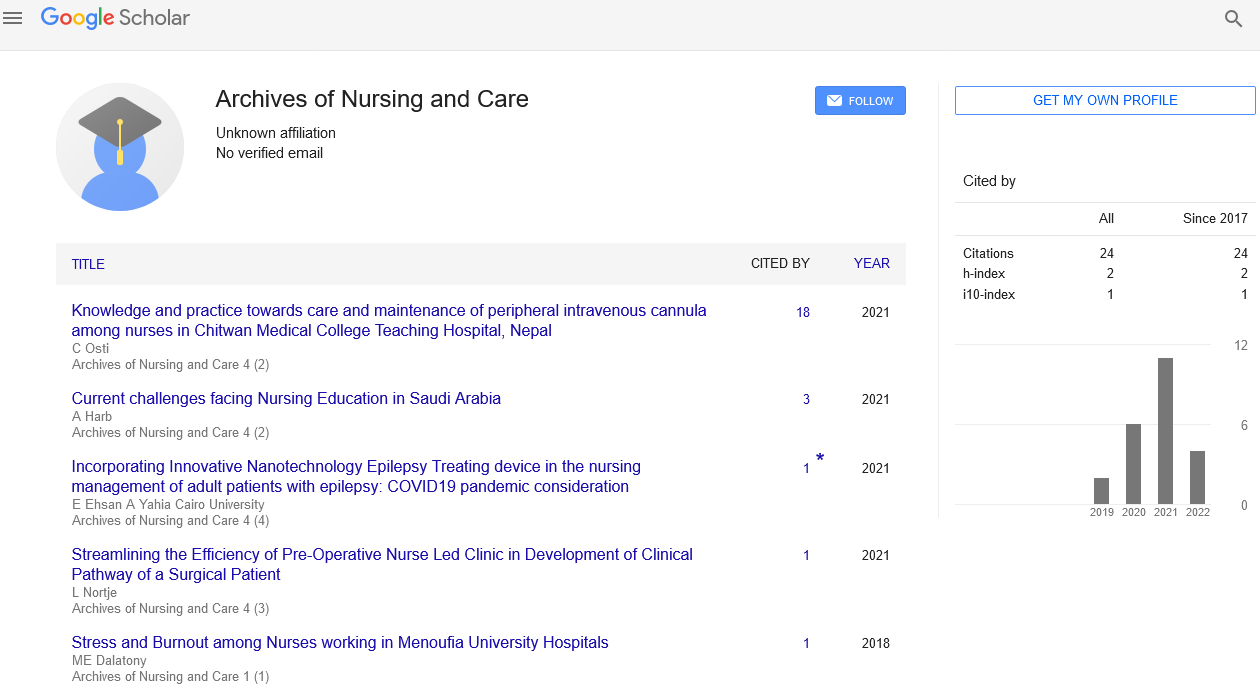Editorial - Archives of Nursing and Care (2022) Volume 5, Issue 9
Employee Welfare Concerns for Intensive Healthcare Professionals
Joel Katz*
Faculty of Social Sciences, Radboud University, Nijmegen, The algeria
Faculty of Social Sciences, Radboud University, Nijmegen, The algeria
E-mail: joel@123.com
Received: 04-Dec-2022, Manuscript No. oanc-22-83792; Editor assigned: 06-Dec-2022, PreQC No. oanc-22- 83792 (PQ); Reviewed: 20-Dec-2022, QC No. oanc-22-83792; Revised: 26- Dec-2022, Manuscript No. oanc-22- 83792 (R); Published: 31-Dec-2022; DOI: 10.37532/oanc.2022.5(9).101- 102
Abstract
This study compared variations in the quantity and types of occupational health hazards that arise at the beginning and end of careers for intensive care unit (ICU) nurses and nursing technicians. With the help of 26 nurses and 96 nursing technicians from a public hospital in Brazil's Federal District, a descriptive cross-sectional study was conducted. The presence of physical, psychological, and social risks was assessed using a Likert-type workrelated symptom scale (WRSS). The SPSS, version 12.0, and the Kruskal-Wallis test were used to examine the data for statistical significance and differences in occupational health hazards at the start and end of the employees' careers. ICUs can present work health dangers to nurses and nursing students, most of which are physical. technicians because they frequently employ their physical stamina and strength to give treatment, while social and psychological risks are less common.
Keywords
Intensive care unit (ICU) • Work-related symptom scale (WRSS)
Introduction
Health risks to health workers, particularly to nurses and nursing technicians, are becoming more well acknowledged. In order to prevent harm to the workers' health in a critical setting like an ICU [1], it is necessary to identify the hazards there as well as preventative measures in various research Depending on how hard the activity is, nurses' and nursing technologists' signs of stress can [2] take many different forms. Physical and mental weariness is undoubtedly among the most prevalent stresses.
Nurses and nursing technicians make up the majority of the nursing personnel in an ICU in Brazil, notwithstanding their technical differences. In addition to delivering care, especially during more complicated procedures, nurses also organise the surroundings, manage the nursing staff's workload, and coordinate patient care. [3] In general, nursing technicians are in charge of providing direct patient care, such as dressing changes, bandage placement, and medication administration.
The stresses linked with the position held in the labour process, according to some studies, may explain why indicators of extreme mental exhaustion are slightly more common in nurses who hold jobs that are hierarchically superior to nursing technicians. [4] Due of the physical care that patients demand, other studies show that nursing technicians are more likely to experience high physical workloads.
Given the vital roles played in crucial patient care, nurses and nursing technicians are subject to extreme weariness despite the technical and hierarchical disparities. These include making snap decisions and prioritising actions with a keen sense of responsibility; solving complex problems; constantly rearranging tasks as a result of interruptions; managing sizable volumes of variable data as a result of concurrent treatments; and executing a wide range of interventions needed by critical clinical conditions.
Approach
This descriptive cross-sectional study, which involved nurses and nursing technicians at the ICU of the Hospital de Base (HBDF), [5] a public facility in Brasilia, DF, Brazil, sought to identify the prevalence of an event in a specific population in order to explain variations in their frequency [15]. 38 beds make up the ICU, 12 of which are set aside for adult patients, 10 for children, 8 for trauma situations, and 8 for people with cardiac issues.
A case: There are 126 nurses on staff in the ICU where the study was done. The sample, which was chosen in a non-probabilistic manner, included 122 participants. [6] Of these, 26 were college-educated nurses in charge of care management [16], and 96 were nursing technicians, who are licenced technical professionals in charge of providing direct patient care while working under the supervision of nurses.
Conclusion
In spite of the requirement to work night hours and on weekends, which are typically regarded as difficult, nursing care at ICUs for both professional [7] groups did not significantly contribute to the occurrence of social hazards in this study.
According to the results of the current study, there was no discernible difference in the physical, psychological, and social risks faced by ICU nurses and nursing technicians at the beginning and end of their careers, proving that there is no cumulative effect because fatigue is a natural result of the work itself. [8] The workers' adaptability to the current working conditions might be a tenable answer.
Acknowledgment
The author would like to [9] acknowledge his Faculty of Social Sciences, Radboud University, Nijmegen, The algeria for their support during this work.
Conflicts of Interest
The author has no known conflicts [10] of interested associated with this paper.
References
- Abbai R, Singh VK. Haplotype analysis of key genes governing grain yield and quality traits across 3K RG panel reveals scope for the development of tailor‐made rice with enhanced genetic gains. Plant Biotechnol J. 17, 1612-1622 (2019).
- Abe A, Kosugi S. Genome sequencing reveals agronomically important loci in rice using MutMap. Nat Biotechnol. 30, 174-178 (2012).
- Abinaya ML, Kumaravadivel N. Screening the genotypes of sorghum (Sorghum bicolor (L.) Moench) BC1 F3 generation of the cross CO (S) 28 x IS18551 for shoot fly (Atherigona soccata (Rond.) resistance. EJPB. 10: 1133-1139 (2019).
- Afolayan G Marker assisted foreground selection for identification of striga resistant backcross lines in Sorghum Bicolor. Covenant. 7, 29-36 (2019).
- Anderson SN, Stitzer MC. Transposable elements contribute to dynamic genome content in maize. TPJ. 100, 1052-1065 (2019).
- Austin RS, Vidaurre D. Next‐generation mapping of Arabidopsis genes. TPJ. 67, 715-725 (2011).
- Avni R, Nave M. Wild emmer genome architecture and diversity elucidate wheat evolution and domestication. Sci .357, 93-97(2017).
- Baumann K. Plant gene editing improved. Nat Rev Mol Cell Biol. 21, 66-66 (2020).
- Bukowski R. Construction of the third-generation Zea mays haplotype map. GigaScience. 7, 1-12 (2018).
- Chandra AK, Kumar A. Microbial-assisted and genomic-assisted breeding: a two way approach for the improvement of nutritional quality traits in agricultural crops. biotech.10, 1-15(2020).
Indexed at, Google Scholar, Crossref
Indexed at, Google Scholar, Crossref
Indexed at, Google Scholar, Crossref
Indexed at, Google Scholar, Crossref
Indexed at, Google Scholar, Crossref
Indexed at, Google Scholar, Crossref
Indexed at, Google Scholar, Crossref
Indexed at, Google Scholar, Crossref

